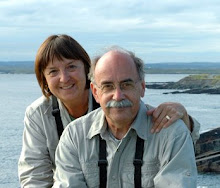Consistent with the night before, we left the hotel as we had arrived - in the dark.
Portions of Cajas NP were not open to us without a park guide onboard. José had made arrangements ahead of time to stop near of one of the park’s entrances to pick up Diego, a qualified park naturalist. Miguel ultimately proved to be a fountain of information over the course of the morning answering questions about the park’s natural history and flora and fauna.
Our first stop was at an interpretive center. Roaming the grounds were Llama, our first close-up looks. They were represented as wild llama although several bore ear tags indicating they were part of a controlled herd. Free to roam "wild", at least within the park’s supervised boundaries. Measuring 111 square miles, Cajas has a lot of space to roam.
The park is situated in a section of older Andes, thus Cajas lacked active volcanoes. And being older, the peaks exhibited more erosion and were overall lower than peaks in northern Ecuador. One similarity with the northern Andes was the presence of Polylepis trees, "Arbol de Papel" or “paper tree” due to its papery bark. It is of the highest altitude growing tree species in the world.
We hiked back to a Lago Llavijuci where we picked up: Andean Teal, White-cheeked Pintail, Carunculated Carcara, Andean Coot, and Andean Gull. A flock of a species we had already seen earlier in the tour, Red-crested Cotingas, was present in an unusually large number.
Back on the bus we rode to a more public park entrance. Within park boundaries again, we stopped along the road and walked through an Elfin forest of Polylepis trees. The texture of the reddish papery bark reminded us of birch trees. The trees were weighted down with epiphytes, bromeliads and arboreal ferns. At any moment we expected to see Bilbo Baggins pop out (we settled on birds).
We walked/rode to another interpretive center on the shore of Laguna Toreadora where we hiked around a portion of the lake's craggy rocky outcroppings, carpeted with a microcosm of flowers and deep velvety mosses.
Since we were continuing toward Guayaquil without returning to Cuenca, we heartily thanked Diego, said our farewells and pushed on (he would catch a shuttle ride back with other park guides).
Before leaving the park we pulled over for one more short bird hike and to dig into our box lunches. Our combined birding at Cajas NP netted us several high elevation specialties: Andean Tit-Spinetail, Mouse-colored Thistletail, Undulated Antpitta (heard only), Tawny Antpitta, White-throated Tyrannulet, Tufted Tit-Tyrant, Brown-backed Chat Tyrant, Cinereous Conebill, Black Flowerpiercer, Scarlet-bellied Mountain-Tanager, Plumbeous Sierra-Finch, Variable Hawk, Bar-winged Cinclodes, and Stout-billed Cinclodes. Our last stop in particular gave us close-up looks at a Tit-like Dacnis. As for new hummingbirds on the day we added: Sparkling Violetear, Ecuadorian Hillstar, Great Sapphirewing, Sword-billed Hummingbird (a quick flyover), Sapphire-vented Puffleg, Violet-throated Metaltail, and Blue-mantled Thornbill.
We also noted a few more “bankable birds”: Grass Wren (a Sedge Wren subspecies), Andean Ruddy Duck (a Ruddy Duck subspecies), and Ecuadorian Rail – heard only (a Virginia Rail subspecies).
Our route back to Guayaquil took us across the continental divide of the Andes. The straight-line distance to the ocean at the pass summit was dramatic: about 35 kilometers, which represented a drop in elevation of some 4,000 meters. But we rarely went in a straight line anywhere. Were we a raindrop, we would have a journey of 200 miles to the Pacific, or, a 4,000-mile sojourn to the Atlantic, depending on which side of the pass we had fallen. As people on a bus? Our relative return to sea level would be far more rapid.
By now we had seen or heard nearly 500 species of birds and traveled through five provinces. Sadly, this was also the last day of our “official tour”. Most of the group had signed up for a three-day extension but this would be Naomi and Jim’s final day with the group. A few days earlier they had investigated staying on for the extension. We would have loved to have them continue on, but after looking into what it would cost to rearrange their flights, plus scheduling issues at home, they decided that it was simply going to be too much of a hassle.
While today’s bus time would be less than the day before, we still wouldn’t reach Guayaquil until late afternoon. Jim and Naomi needed time to repack, join in our official end-of-tour farewell dinner and still be able to depart the Hotel Continental no later than 9:30 PM to make their flight. Fortunately we arrived in time for all this to happen…and they still had about ten minutes leftover to rest! But then why should today be any different from the regular tour’s “birding boot camp” pace?
In addition to the daily checklist tally, everyone shared their top five favorite trip birds. It prompted much laughter and smiles remembering various birds and the circumstances surrounding the sightings (White-capped Dipper was a big hit). After many hugs and handshakes, we bid farewell to Jim and Naomi and retired to our rooms to prepare for the trip extension: a visit to the Ecuador coast.



No comments:
Post a Comment